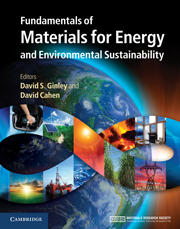Book contents
- Frontmatter
- Contents
- Contributors
- Preface
- Acknowledgments
- Part 1 Energy and the environment: the global landscape
- Part 2 Nonrenewable energy sources
- Part 3 Renewable energy sources
- 17 Solar energy overview
- 18 Direct solar energy conversion with photovoltaic devices
- 19 Future concepts for photovoltaic energy conversion
- 20 Concentrating and multijunction photovoltaics
- 21 Concentrating solar thermal power
- 22 Solar thermoelectrics: direct solar thermal energy conversion
- 23 Off-grid solar in the developing world
- 24 Principles of photosynthesis
- 25 Biofuels and biomaterials from microbes
- 26 Biofuels from cellulosic biomass via aqueous processing
- 27 Artificial photosynthesis for solar energy conversion
- 28 Engineering natural photosynthesis
- 29 Geothermal and ocean energy
- 30 Wind energy
- Part 4 Transportation
- Part 5 Energy efficiency
- Part 6 Energy storage, high-penetration renewables, and grid stabilization
- Summary
- Appendix A Thermodynamics
- Appendix B Electrochemistry
- Appendix C Units
- Index
- References
26 - Biofuels from cellulosic biomass via aqueous processing
from Part 3 - Renewable energy sources
Published online by Cambridge University Press: 05 June 2012
- Frontmatter
- Contents
- Contributors
- Preface
- Acknowledgments
- Part 1 Energy and the environment: the global landscape
- Part 2 Nonrenewable energy sources
- Part 3 Renewable energy sources
- 17 Solar energy overview
- 18 Direct solar energy conversion with photovoltaic devices
- 19 Future concepts for photovoltaic energy conversion
- 20 Concentrating and multijunction photovoltaics
- 21 Concentrating solar thermal power
- 22 Solar thermoelectrics: direct solar thermal energy conversion
- 23 Off-grid solar in the developing world
- 24 Principles of photosynthesis
- 25 Biofuels and biomaterials from microbes
- 26 Biofuels from cellulosic biomass via aqueous processing
- 27 Artificial photosynthesis for solar energy conversion
- 28 Engineering natural photosynthesis
- 29 Geothermal and ocean energy
- 30 Wind energy
- Part 4 Transportation
- Part 5 Energy efficiency
- Part 6 Energy storage, high-penetration renewables, and grid stabilization
- Summary
- Appendix A Thermodynamics
- Appendix B Electrochemistry
- Appendix C Units
- Index
- References
Summary
Focus
Thermochemical aqueous processing of cellulosic biomass requires depolymerization of long chains of carbohydrate molecules into fragments that can be metabolized by micro-organisms or catalytically converted to fuels and chemicals. This chapter focuses on such processes for carbohydrate depolymerization and their integration with subsequent product-formation steps in an effort to produce ethanol and other biofuels.
Synopsis
Cellulosic biofuels, which once were widely used but whose usage dropped sharply upon the introduction of refined petroleum products to the energy supply, can be a cost-effective fuel with applications in vital areas. Current strategies focus on maximizing the efficiency of conversion of cellulosic biomass waste into energy-rich products, especially liquid fuels, such as alcohols and other hydrocarbons. Recent research on the chemical and biological pretreatment of cellulosic feedstock materials shows promise for surpassing thermal processes in catalyzing the breakdown of cellulose and lignin, which is a crucial first step in the production of useful fuels. Chemical pretreatments include autohydrolysis, application of low and high pH (i.e., acids and bases), exposure to ammonia, and treatment with organic solvents and ionic liquids. Each of these methods is effective at breaking cellulose down so that it can be more easily digested enzymatically. These techniques generally offer good yields from a variety of feedstocks and therefore should be broadly applicable. In particular, it is expected that feedstocks will include waste materials such as food-crop residues (e.g., corn stover and sugarcane bagasse) and dedicated energy crops (e.g., switchgrass) that can be grown on otherwise agriculturally poor land. This aspect is particularly important in terms of minimizing the societal and environmental impacts of biofuels technology. For example, use of such feedstocks is intended to eliminate competition with food crops for arable land, which could lead to sharp increases in food prices. It should also help minimize the issue of indirect land-use change (see Chapter 2) that could actually result in increased CO2 emissions.
- Type
- Chapter
- Information
- Publisher: Cambridge University PressPrint publication year: 2011
References
- 2
- Cited by

